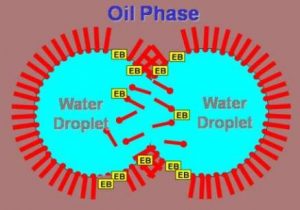- Tightness of the emulsion.
- Specific gravity of the oil and produced water.
- Corrosiveness of the crude oil, produced water, and casing head gas.
- Scaling tendencies of the produced water.
- Quantity of fluid to be treated and percent water in the fluid.
- Paraffin-forming tendencies of the crude oil.
- Desirable operating pressures for equipment.
- Availability of a sales outlet and value of the casing head gas produced.
Why Remove Water?
- Wet Oil has Little Value
– Refineries usually specify <0.5% water
- The presence of water can lead to corrosion
– In shipping lines and process equipment
– In Refinery process systems
- System Designs
– Most oil production systems are sized for oil
- Transport Costs
– Transporting a by-product with no value is wasteful
- Removing water from oil (Deoiling), although desirable, creates potential problems:
– Disposal of oily separated water
- Standards from as high as 40ppm hydrocarbon (offshore) to as low as 5ppm hydrocarbon (onshore)
- Standards often exceeded due to operational problems
– Solids build up in production systems
What is an Emulsion?
- Definition: A mixture of two immiscible liquids, one of which is dispersed as droplets in the other, this dispersion being stabilized by an emulsifying agent.
- Water in Oil Emulsions (W/O)
– “Normal” Emulsion
– Continuous phase – Oil
– Dispersed phase – Water
Oil in Water Emulsions (O/W)
– “Reverse” Emulsion
– Continuous phase – Water
– Dispersed phase – Oil
- Two Immiscible Liquids
– Oil and Water
Source of Oil and Water:
What is Required For Emulsion Formation?
- Two Immiscible Liquids
– Oil and Water
- A Source of Mixing Energy / Shear
– Well Bore, Pumps, Choke, Valves, Bends in Pipework, Flow Regime (Turbulent Flow)
What is Required For Emulsion Formation?
- Two Immiscible Liquids
– Oil and Water
- A Source of Mixing Energy / Shear
– Well Bore, Pumps, Choke, Valves, Bends in Pipework, Flow Regime (Turbulent Flow)
- An Emulsifying Agent(s)
– Solids e.g. Formation Fines, Corrosion Products, Scale
– Treatment Chemicals – Production and Drilling
– Natural Surfactants – e.g. Paraffins, Naphthenic Acid Salts
Major Factors Affecting “Normal” Emulsion Stability
- Type and Amount of Emulsifying Agent(s)
- Degree of Agitation (mixing)
- Viscosity of Continuous Phase – Stokes’ Law
- Density Differential of Produced Fluids – Stokes’ Law
- Disperse Phase Content (Water)
– as water content increases emulsion stability decreases (generally)
- Emulsion Age
– emulsion stability generally increases with time
- Temperature
– affects other variables
– emulsion stability decreases with increase in temperature
Stokes’ Law:
V = Velocity of water droplet
r = Radius of water droplet
dw = Density of water
do = Density of oil
u = Viscosity of oil
g = Constant
- Water droplet radius is a squared function in Stoke’s Law
- Therefore, water droplet settling velocity is most easily increased by increasing the radius of the droplets
- Hence, any means of coalescing the water droplets will increase settling velocity and reduce the settling time needed for water separation.
Resolving “Normal” Emulsions
- Demulsification
Defined as:-
“The resolution of crude oil emulsions and the subsequent removal of the separated water phase (dehydration)”
read more about Crude Oil Stabilization and Sweetening
The Mechanism of Demulsifiers
- To Break (or destabilise) a “Normal” Emulsion a Demulsifier Must Achieve the Following:-
– Rapid Migration to the oil/water interface
– Flocculation
– Coalescence
– Solids Wetting
Factors In Demulsification
Solids Removal
- Removal of solids from the interface may completely resolve some emulsions
- Types of Solids:-
– Inorganic
- FeS, mineral scale (e.g. CaCO3), silt, clay, drilling muds
– Organic
- Paraffin, asphaltenes
- Solids removal can be achieved by:-
– Oil wetting (dispersion in oil)
– Water wetting (dispersion in water)
References:
1. Surface Production Operations – Ken Arnold & Maurice Stewart.
2. Production Chemistry & Corrosion Control – Baker Petrolite

